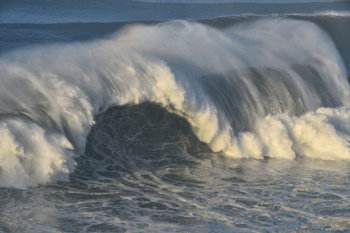Rogue Waves Can Cause Big Damage

They are mysteries of the sea: huge walls of water called rogue waves that seemingly appear out of nowhere and can reach heights of 90 feet and can sink a big ship in extreme cases. The good news is that they are rare and it takes just the right conditions to form them, says a Texas A&M University oceanographer.
Achim Stössel, who was with the merchant marine for several years before pursuing a career in oceanography, says rogue waves can be found where wave fields from different wind systems meet. This occurs mostly in wide mid-latitude ocean basins that are frequently exposed to strong winds.
Rogue waves are not tsunamis, which are generated by subsea earthquakes.
“Rogue waves are a result of different swell interfering constructively, that is two wave fields combining such that two wave crests add up to produce a much taller wave. Another way they are caused is the interaction of waves with surface currents,” Stössel explains.
“Strong currents, such as the Gulf Stream, often feature small-scale jets around which wave crests tend to bend (refract) and converge, thus creating taller waves. Therefore, regions affected by strong currents, such as the Gulf Stream, are more prone to rogue waves. Another example is the Agulhas Current that runs southwestward around South Africa, where it meets tall waves that are generated by the prevalent westerlies in this region.”
A whale-watching ship off the western Canadian coast appears to have been sunk last month by a rogue wave, and it capsized the boat, killing 5 of the 21 people on board who were watching sea lions at the time. Survivors said the large wave “came out of nowhere.”
Other known rogue wave incidents: In 1933, the Ramapo, a U.S. Navy transport ship, detected a rogue wave in the northern Pacific that measured 34 meters (102 feet) in height, and in 1942, the RMS Queen Mary was carrying thousands of U.S. troops when it was hit by a 70-foot rogue wave in the Atlantic and nearly capsized.
In recent years, the MS München, a 37,000-ton German freighter, radioed a distress call in 1978 in the Atlantic that a huge wave had struck the ship. No survivors were found.
There has been speculation that the Edmund Fitzgerald, an iron ore-carrying ship that sunk in Lake Superior in 1975 killing all 29 men on board and was made popular by a well-known song, was hit by a rogue wave, though this has never been proven.
Stössel strongly doubts the existence of rogue waves in small basins like the Great Lakes.
“Rogue waves can reach a wave height of 30 m (about 90 feet), and they can cause great damage on a ship to the point that it sinks,” he adds.
“You can generally see the crests of tall waves on a radar, but since rogue waves would emerge in a field of waves that are tall to start with, and since the piling up of water masses that eventually create a rogue wave occurs localized on rather short notice, it would be hard to detect a rogue wave on a radar with enough lead time to circumnavigate it.”
“Rogue waves are not expected in the Gulf of Mexico because of its limited width, the lack of strong winds blowing persistently from the same direction and possibly because of only minor jets in surface currents,” he adds.
Media contacts:
- Achim Stossel, astoessel@tamu.edu.
- Keith Randall, Texas A&M News & Information Services, keith-randall@tamu.edu.





